I adore the variety of the changing seasons, from the quiet blanket of snow in the winter to the blissful feeling of sun on my skin during the summer.
But when Old Man Winter is on the verge of overstaying his welcome, there’s no better way to show him the door than seeing the cheerful color of redbuds in bloom.
Now, if only I could narrow it down to one or two varieties…
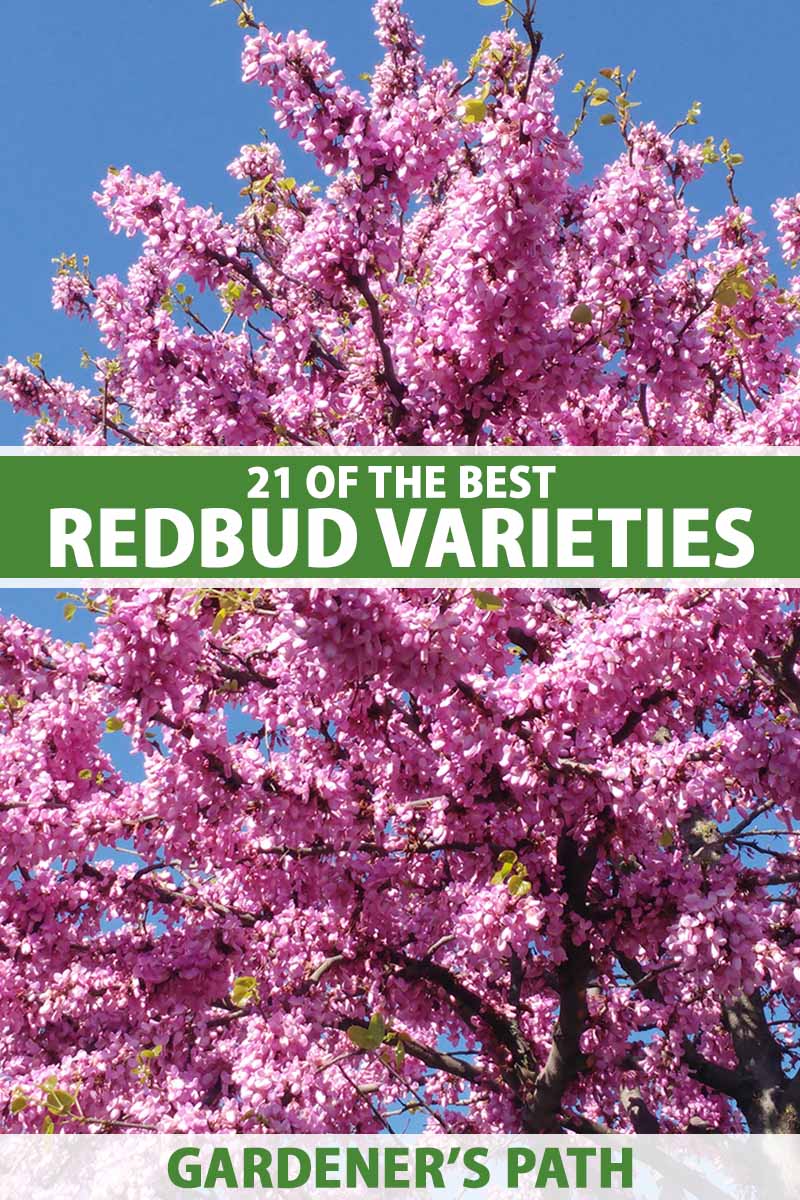
We link to vendors to help you find relevant products. If you buy from one of our links, we may earn a commission.
Redbuds aren’t just for those hoping to add some spring color to the landscape.
These days, they come in weeping forms, and versions with zig zagging branches. You can find ones with red, orange, and pink foliage in the summer or variegated leaves that dance in the breeze.
Ready to take a look? Here’s a quick preview of all the enticing options we’ll cover in this roundup:
All Cercis canadensis, or eastern redbud, cultivars need about 700 chill hours below 50°F to bloom well.
C. texensis cultivars (including var. texensis ‘Oklahoma’) , California redbuds (C. occidentalis), and Chinese redbuds (C. chinensis) all need about 500 chill hours.
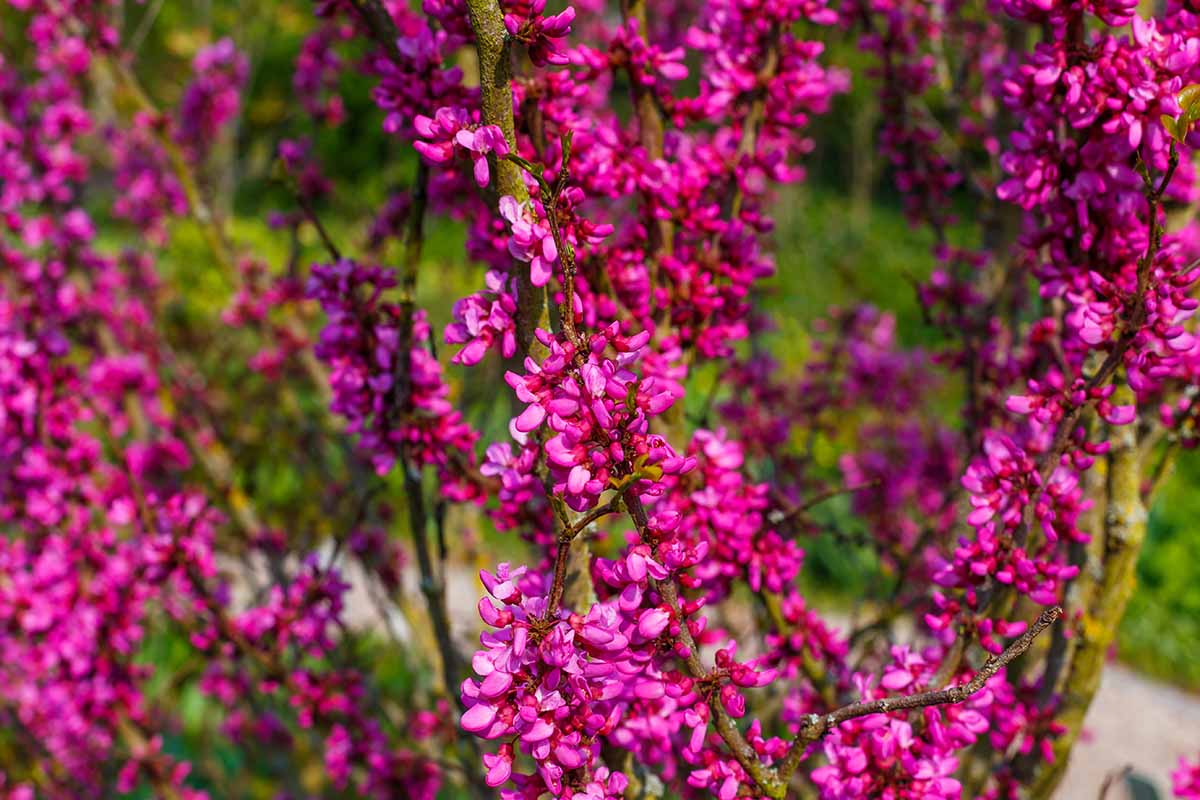
Most redbuds will still bloom if they’re a little short on chill hours, but they’ll bloom much more profusely and with more color if they experience the amount they need.
Redbuds are cauliflorous, which means that the flowers emerge on the bare trunk and branches in the spring before any foliage has poked out. The flowers are then gradually replaced by foliage.
You can learn more about redbuds and how to grow them in our guide.
Unless otherwise noted, C. canadensis and C. chinensis cultivars do well in USDA Hardiness Zones 5 to 9.
Western (C. occidentalis) and California redbuds are less hardy, growing best in Zones 7 to 9.
1. Ace of Hearts
C. canadensis ‘Ace of Hearts’ is small in every way. The dwarf-sized plant only grows to about 12 feet tall with an upright habit, and the leaves and flowers are proportionately small.
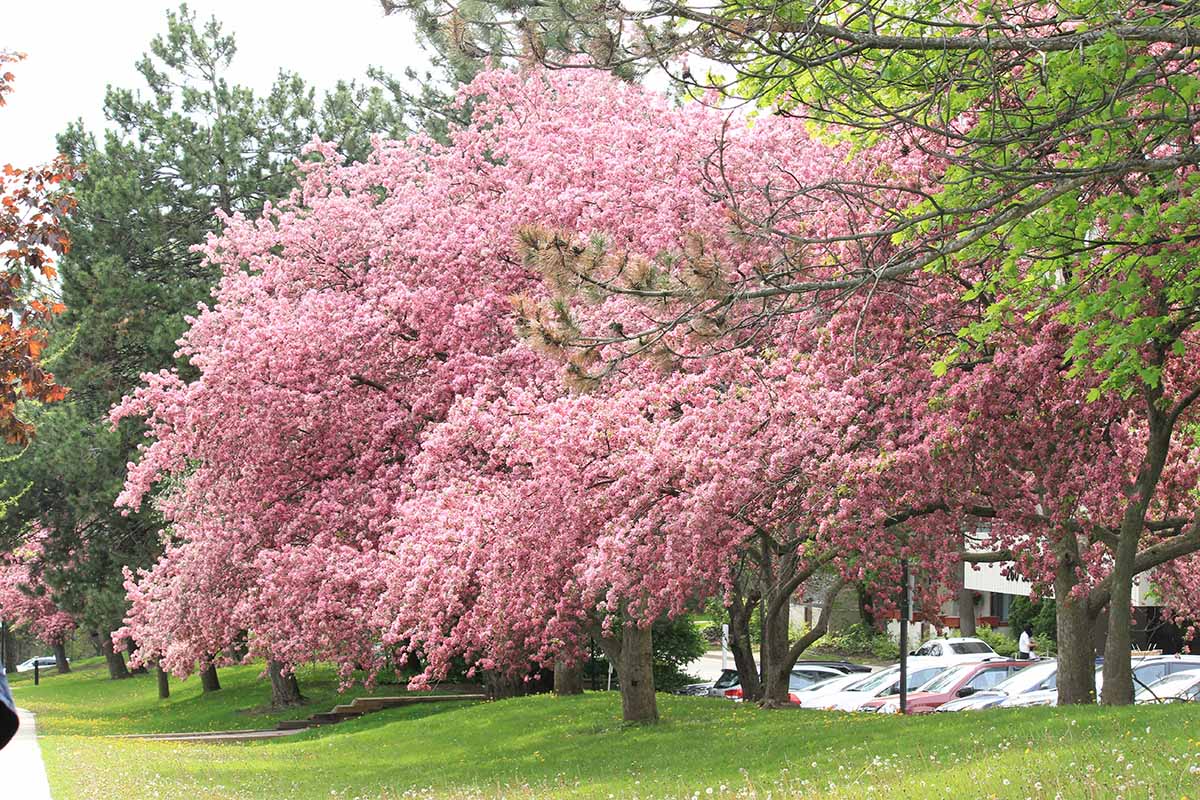
While all redbuds have heart-shaped leaves, the foliage on this cultivar is particularly perfectly heart-shaped.
The effect is a compact, dense form with a plethora of tiny green hearts trembling in the breeze.
This redbud tends to grow as wide as it is tall, with a symmetrical canopy and symmetrical leaf growth. It makes a pleasing, clean architectural statement in the yard.
But don’t forget the blooms! The spring flowers are rose pink with a hint of purple.
If you want an option that you can grow as either a large shrub or a small tree, depending on how you prune it, pick up this winner at Fast Growing Trees.
They carry live trees in two- to three-, three- to four-, and four- to five-foot sizes.
2. Alley Cat
Named in 2016, ‘Alley Cat’ is one tough customer.
This C. canadensis cultivar was found growing wild in an alley in Louisville, Kentucky by Allen Bush, who gave it to Harald Neubauer of Hidden Hollow Nursery to cultivate and sell.
It has been bringing its sassy variegated foliage to backyards across the US ever since.

Honestly, I love underdog success stories, so I’d probably adore this option no matter what.
But it’s one of the most striking redbuds out there, with three-season interest that never fails to draw comments.
The heart-shaped leaves are medium-green and liberally speckled with creamy-white blotches, but before that, when they emerge in the spring, they’re surprisingly pink.
Sometimes variegated foliage can scorch in the sun, but ‘Alley Cat’ maintains its color even in full exposure.
The flowers are bright purple-pink, covering the 20-foot-tall and 30-foot-wide tree in a dense blanket of color.
Give this ‘Alley Cat’ a good home by grabbing one at Nature Hills Nursery.
3. Avondale
This semi-dwarf C. chinenis cultivar stands out because of its nearly neon pink flowers that absolutely envelope the branches in color so intense it seems unnatural.
It’s also one of the most floriferous of all the redbuds.
Topping out at about 12 feet, this is a good option if you want to grow a redbud in a container, where it will stay even more compact.
For a big impact in a small package, grab a four- to five- or five- to six-foot ‘Avondale’ from Fast Growing Trees. Depending on how you prune it, you can grow it as a large shrub or small tree.
4. Black Pearl
Lovers of dramatic gardens filled with midnight-hued plants, gather ‘round.
Black Pearl™ has large, heart-shaped leaves that are so dark purple that they appear to be black, particularly in the fall when the leaves turn darker.
This C. canadensis cultivar has such beautiful foliage that the blossoms are almost an afterthought. Preceding the leaves, they’re a lovely lavender color.
When I was helping a friend design her black garden, we had no trouble finding black flowers and herbaceous plants, but tracking down a black tree was another matter entirely.
This cultivar fits the bill, and it’s stunning. Even if you aren’t choosing all dark-hued plants for your garden, it’s a surprising accent among the typical flowers and green foliage.
The tree grows about 20 feet tall and 25 feet wide. Feeling the gothic vibes? Head to Nature Hills Nursery to buy a live plant in a #2 container.
5. Carolina Sweetheart
Redbuds are gorgeous when they’re in bloom. Many people pick these just to enjoy the floral show in the spring.
But Carolina Sweetheart® is covered in such colorful, beautiful foliage that you might forget the plant even puts out blossoms.
The leaves almost look like flowers themselves, with maroon, pink, cream, red, and green variegated coloring.
The show continues into the fall as the leaves take on a yellow hue while continuing to retain the pink, red, and maroon shades.
Bred by North Carolina State University horticulturalists, this C. canadensis cultivar can put on a big, bold performance, reaching up to 30 feet tall.
Ready for a sweet show? Pop on over to Nature Hills Nursery for a live plant in a #2 container.
6. Cascading Hearts
Get ready to tumble into love. ‘Cascading Hearts’ is a dwarf C. canadensis cultivar that tops out at just eight feet with a 10-foot spread and an elegant weeping growth habit.
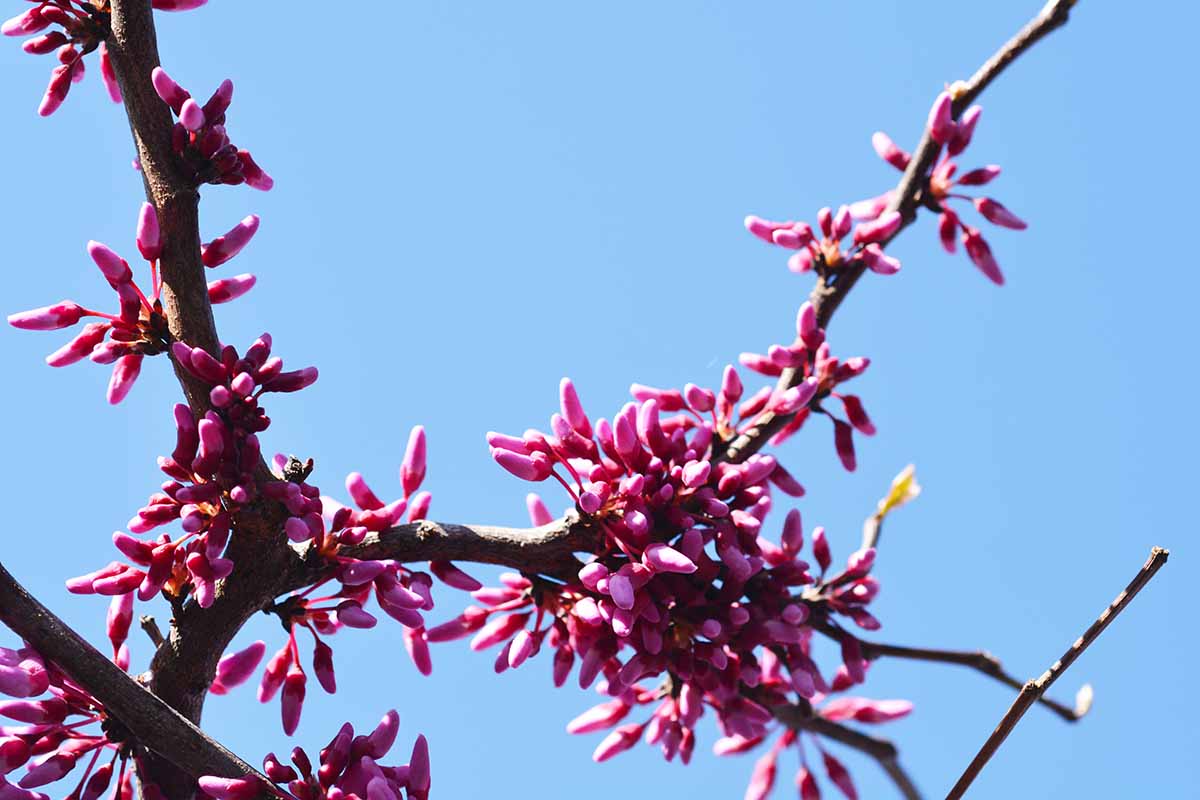
Imagine a pair of these in full bloom in large, elegant pots flanking a doorway. They make a big statement in a petite package.
Even when the trees aren’t in bloom, the weeping branches covered in heart-shaped leaves draw all the attention.
If you’ve fallen in love with ‘Cascading Hearts,’ we get it! Nature Hills Nursery carries live trees in #2 containers.
7. Claremont
Good old western redbud (C. occidentalis) hasn’t been cultivated to the extent that its eastern cousin has.
Native to dry, hot areas like parts of California, Arizona, and Utah, it is extremely drought tolerant and isn’t afraid of extreme heat.
On the other hand, it won’t tolerate too much cold and can’t be grown north of Zone 7.
While the species is perfectly lovely, ‘Claremont’ is even more floriferous with a darker purple-pink hue to the blossoms.
The fall leaves turn brighter yellow than the species and it can tolerate colder regions, as far north as Zone 6.
8. Don Egolf
At a petite 10 feet tall, this Chinese cultivar is perfect when you need something a little bit more petite.

The bright fuchsia flowers reliably appear year after year, even when the tree doesn’t receive the number of chill hours during winter that it prefers.
Since it’s sterile, you don’t have to worry about the mess of seed pods, either.
It’s super disease-resistant, slow growing, and maintains a compact shape without pruning.
‘Don Egolf’ is also incredibly prolific in terms of flowering. You can’t even see the bark underneath when the tree is in bloom.
Want one to grow in your yard? Head to Fast Growing Trees.
9. Forest Pansy
This C. canadensis cultivar is darker overall than the standard species.
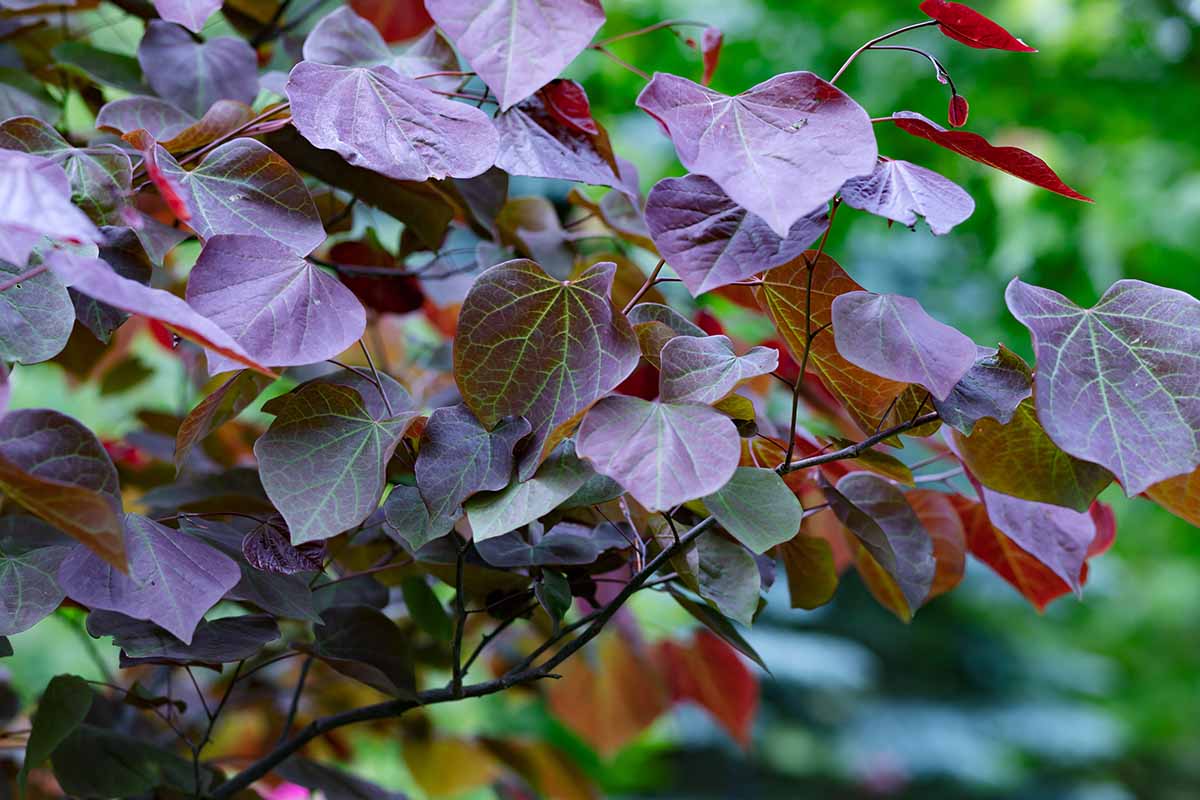
It has purple-red blossoms that stick around for nearly a month, and dark green leaves that first emerge in shades of dark reddish-purple in the spring.
‘Forest Pansy’ will eventually reach 30 feet tall, which means you’re in for a majestic show in the spring.
Pick up a four- to five-, five- to six-, or six- to seven-foot-tall tree at Fast Growing Trees.
10. Golden Falls
A redbud might not be the first that comes to mind when you’re thinking of a columnar option for your garden.
But Golden Falls® is a C. canadensis dwarf that is tall and narrow, with weeping branches.
You could form a living fence with these, grow them in containers, or feature one as the centerpiece in a small garden.
When mature, it’s just eight feet tall and three feet wide. Covered in golden-green leaves, it looks like a golden waterfall of hearts in the summer and a fountain of pink in the spring.
Golden Falls® looks completely unlike any other redbud. Stand out with one of your own from Fast Growing Trees.
11. Lavender Twist
Redbuds garner all the attention in the spring, but the dwarf C. canadensis ‘Lavender Twist’ puts on a four-season show.
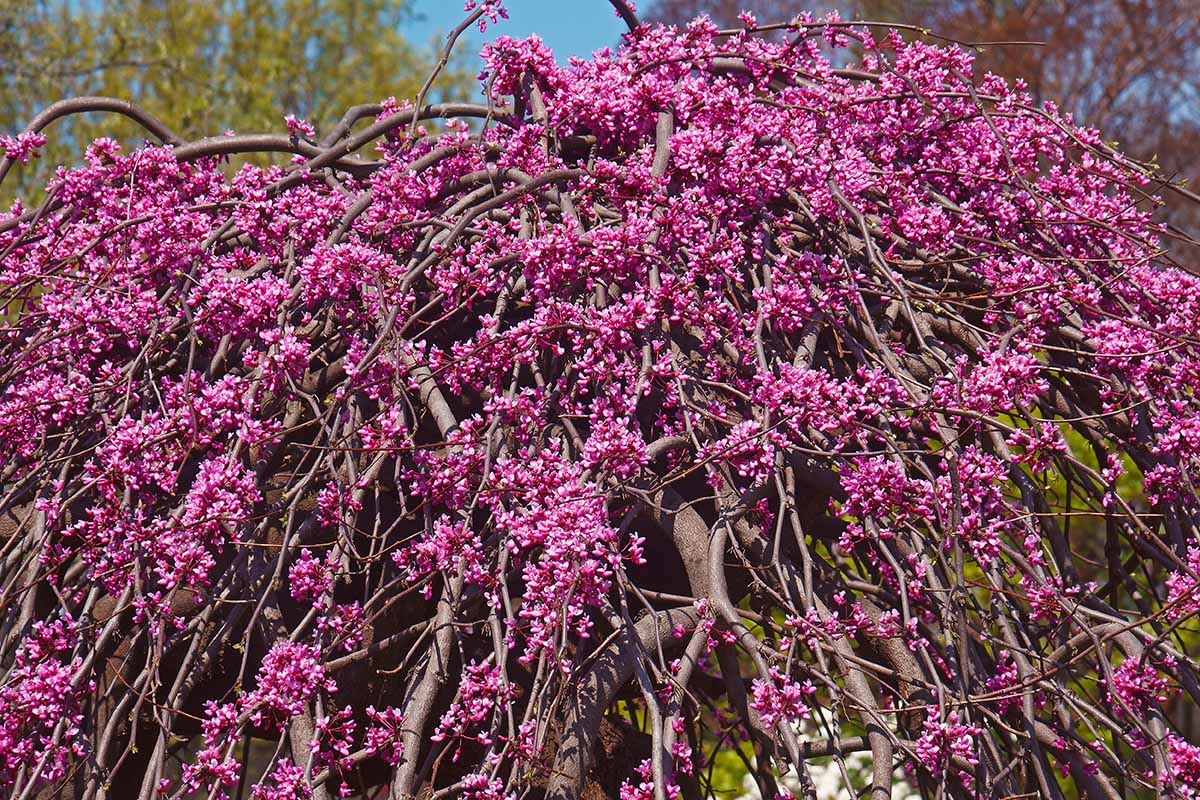
Yes, it has those characteristic lavender poms covering the branches. In the summer, the heart-shaped leaves cascade down the weeping tree before turning yellow in the fall.
Finally, even when all the leaves have fallen, the twisting, weeping branches are an architectural statement, whether covered in snow or simply standing bare in the garden.
It’s so nice, in fact, that this 10-footer took home the top award in the tree category in 2009 at the Georgia Gold Medal Awards.
Whether you want to pot it up or place it in the ground, you can snag a live three- to four-, four- to five-, or five- to six-foot tree at Planting Tree.
Find growing tips for this variety here.
12. Judas Tree
This species is called the Judas tree because it is said in Christian mythology that Judas Iscariot hung himself from one after betraying Jesus. I prefer the more cheerful term “Mediterranean tree.”
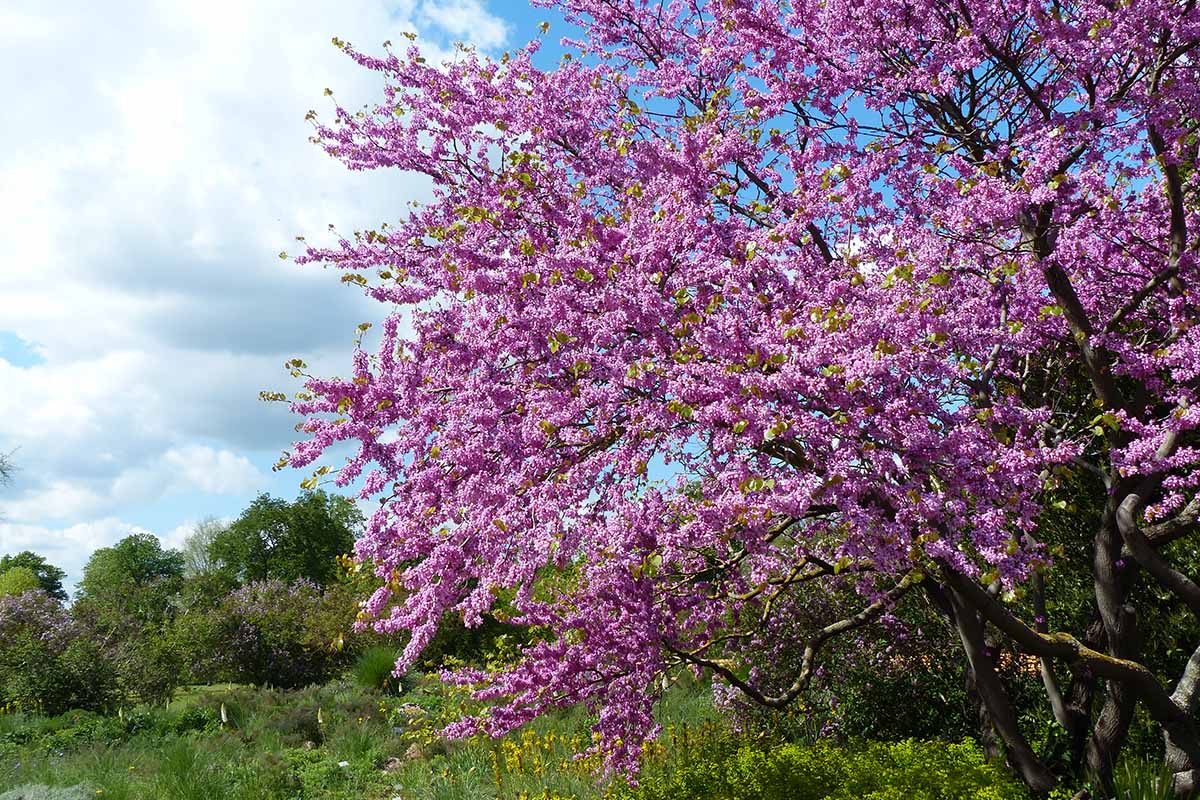
Whatever you call C. siliquastrum, its native range spans western Asia and southern Europe. Now and then, you can find it for sale as an ornamental in North America.
If you happen to find one, grab it. They’re lovely, growing up to 25 feet tall with a thick, full canopy full of heart-shaped leaves that emerge bronze in the spring before shifting to medium green.
The pink-lavender blossoms (or white on the alba variety) give way to purple pods that stick around on the tree for months.
13. Pink Heartbreaker
It’s heartbreaking when a tree doesn’t perform as you want it to. But ‘Pink Heartbreaker’ won’t let you down.
Pink flower fans will fall in love with the lavender-pink blossoms on strong, arching branches that are a feature of this petite, 12-foot-tall tree.
Ready to break hearts, in a good way? Bring home a five- to six- or six- to seven-foot-tall tree from Fast Growing Trees.
14. Pink Pom Poms
It’s easy to see where this C. canadensis hybrid got its name. The big clusters of fully double, reddish-purple flowers look like celebratory pom poms cheering for the arrival of spring.
The heart-shaped leaves provide a glossy show during the summer, and you don’t have to worry about messy pods in the fall, since this redbud is sterile.
Grab one from Fast Growing Trees to bring the celebration to your garden.
15. Rising Sun
Rising Sun™ is a dwarf C .canadensis cultivar that grows up to 12 feet tall with a dense growth habit, which would make it an appealing option in itself.
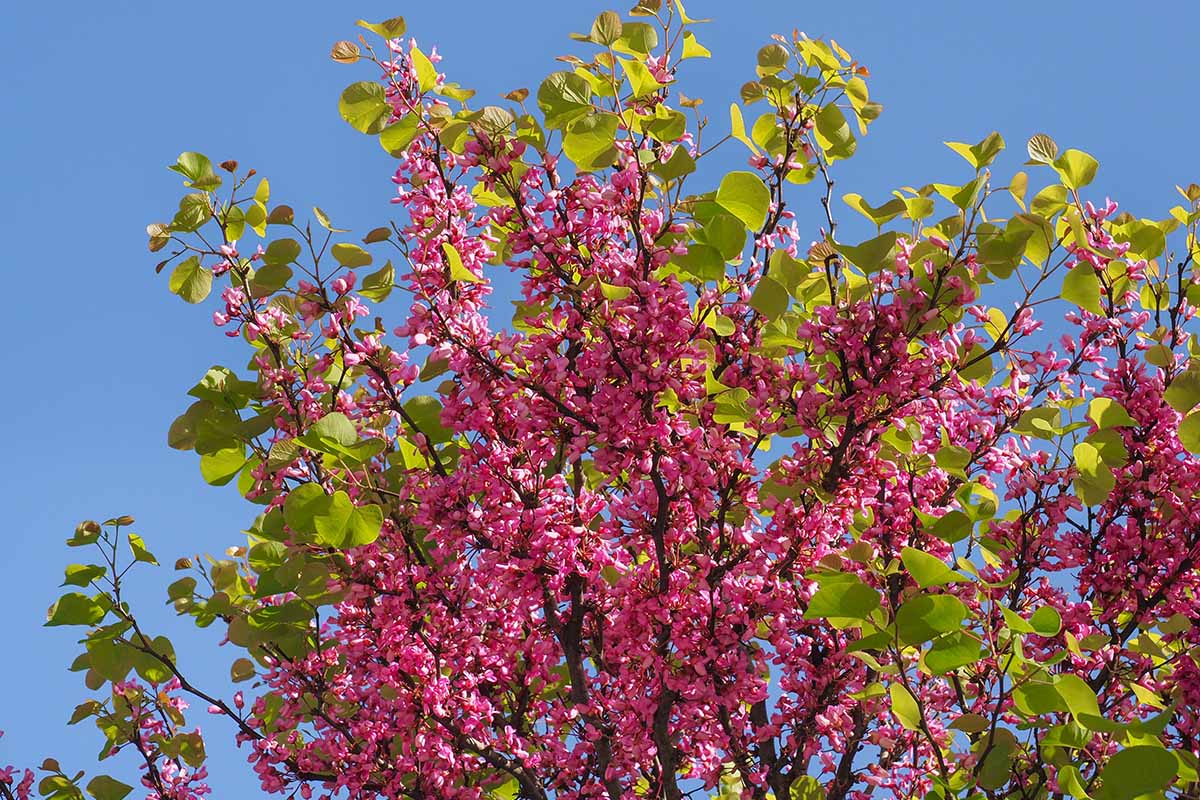
The cheerful reddish-pink poms are classic redbud, and its yellowish, smooth bark adds some color to the winter landscape.
But all that is just secondary to the foliage. Each leaf transitions from peach through orange, gold, and yellow to its mature lime green.
It’s like watching hundreds of small, heart-shaped sunrises throughout the spring and summer.
What could be better than a sunrise that you don’t have to wake up at the crack of dawn to see?
Make it happen in your garden by picking up a three- to four-foot live tree from Fast Growing Trees.
16. Royal White
If you adore upright flowering cherries but you live in a drought-prone area, it’s time you met C. canadensis f. alba ‘Royal White.’
When in bloom, the 30-foot tree resembles a flowering cherry with its frilly white flowers and rounded canopy, but it doesn’t mind dry conditions.
Give your garden the royal treatment and purchase one at Planting Tree.
17. Ruby Falls
‘Ruby Falls’ is a dwarf type, so it stays petite, topping out at about 10 feet tall and spreading six feet wide.
But as you may have guessed from the name, it doesn’t have the typical upright growth habit. The branches are gracefully weeping, like a mauve waterfall.
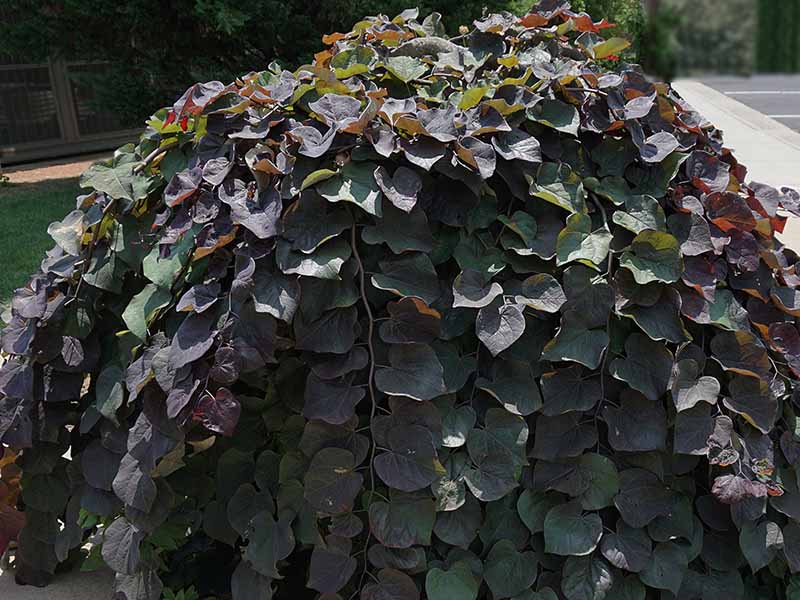
The blossoms are deep purple, with leaves that emerge deep purple before transitioning to deep green over the summer.
Unlike some other weeping varieties like ‘Lavender Twist,’ it doesn’t become bare at the top as it ages.
Bred by Denny Werner of NCSU, a noted redbud breeder, it’s also particularly pest- and disease-resistant.
Fast Growing Trees carries four- to five-foot-tall saplings of this exceptional cultivar should you want to bring one home. And you should!
18. Tennessee Pink
C. canadensis ‘Tennessee Pink’ is appealing because of its dwarf stature, growing no taller than 12 feet, and its broad canopy, which can stretch up to 15 feet wide.
The rounded canopy is wrapped in pure blush pink blossoms that lack the purple hue that many redbuds have.
The blossoms last for at least three weeks before making way for the glossy, dark green leaves. Then, in the fall, the heart-shaped foliage turns bright yellow.
19. Vanilla Twist
How about a C. canadensis redbud with a bit of a twist on the traditional pink-blossomed, upright tree?
‘Vanilla Twist’ has a weeping form that grows about 12 feet tall and eight feet wide with bright white blossoms.
The graceful branches arch down to within a foot of the ground, creating the look of a bubbling fountain of flowers.
Use it as an accent or as the centerpiece in a small garden.
Add a twist to your garden display and grab yourself a tree at Fast Growing Trees.
20. Whitewater
Nope, it’s not white blossoms that make this C. canadensis cultivar look like you’re facing the lower side of your local white water rapids.
This tree has dark purple flowers in the spring. It’s the foliage that gives this eight-foot weeper that look.
The heart-shaped leaves are a mixture of white and green, with some primarily white with just hints of green, and others the opposite.
Young leaves have a faint pink hue, for a frothy swirl of color overall.
Anytime you find a tree bred by Dr. Dennis Werner, a horticulturalist at North Carolina State University, you know you’re probably in for a good thing. That’s definitely the case here.
Ready to experience the thrill? Pick up a #2 container at Nature Hills Nursery.
21. Zig Zag
Zig Zag® is a C. canadensis cultivar unlike anything else out there.
Yes, the magenta blossoms in the spring are beautiful and the bright orange foliage in the fall is eye-catching, but this tree turns heads namely because of its trunk and branches.
The trunk and branches zig and zag back and forth in symmetrical lines, forming a honeycomb effect overall that deserves a double and triple take.
It’s so stellar, whether the tree is covered in snow or blossoms.
Find the Right Redbud for You
Redbuds used to be an easy choice. You want some bright color in the early spring on a tree that isn’t too huge? Grab a redbud.
But these days, some excellent breeders have created cultivars with variegated leaves, weeping forms, white flowers, and pink leaves. We’re spoiled for choice!
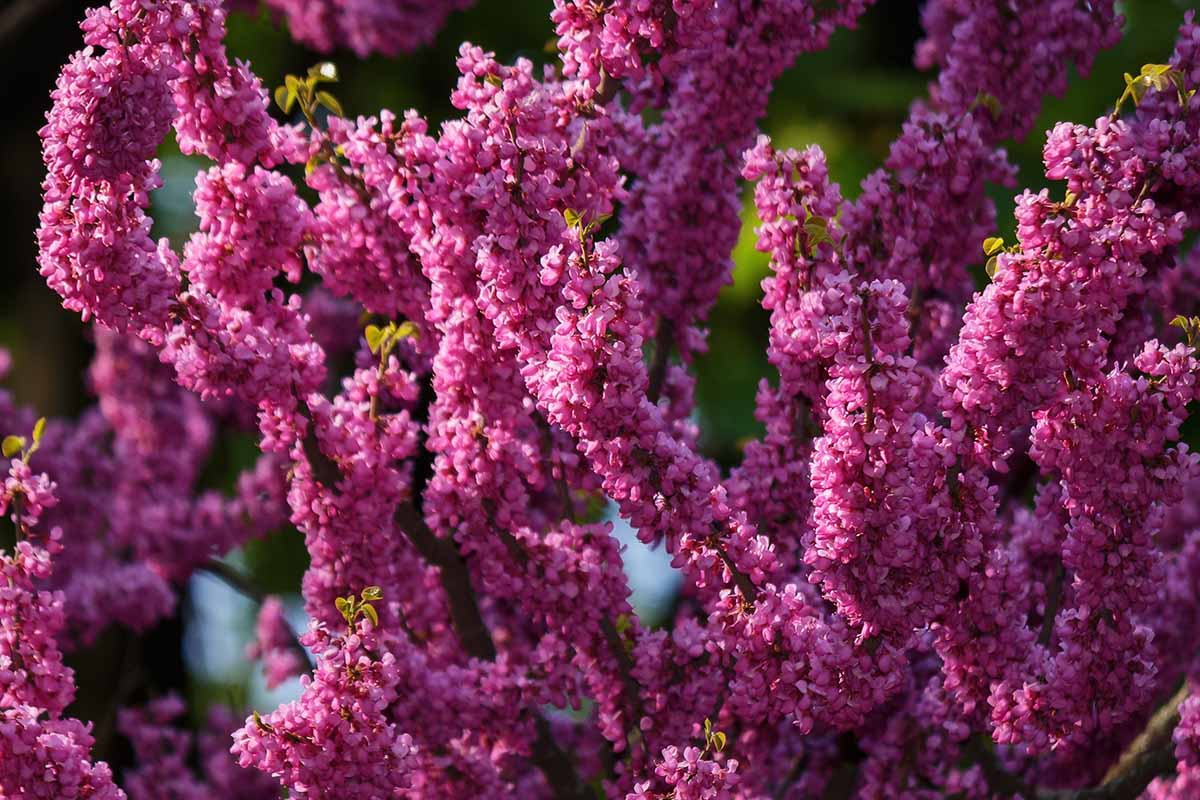
So what about you? Which redbud is calling your name? Did we miss one that you particularly love? Fill us in by leaving a message in the comments below.
If you’d like to bring home a few friends for your redbuds, and you felt like this guide was useful, we have some other guides to landscape trees that can help you make your decision, including:
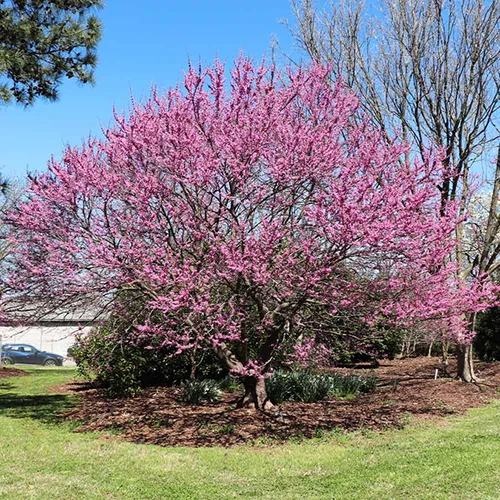

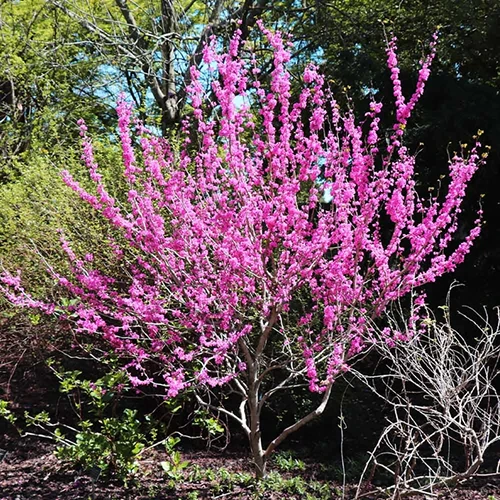
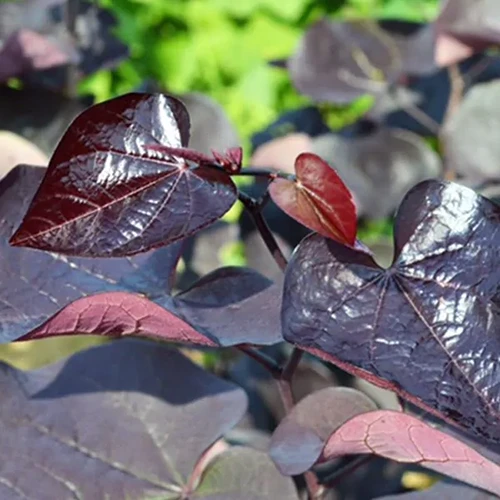
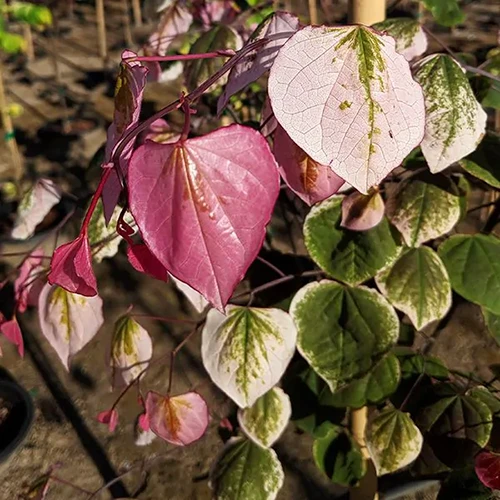
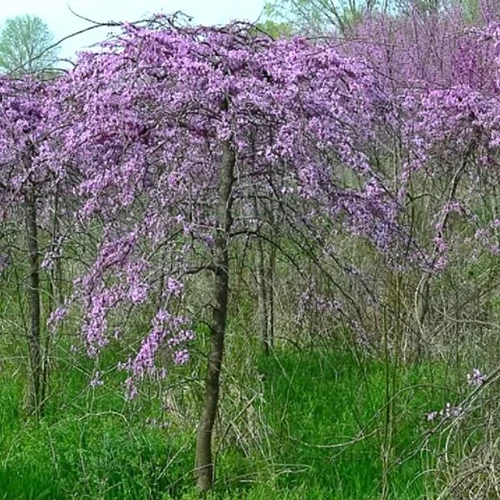
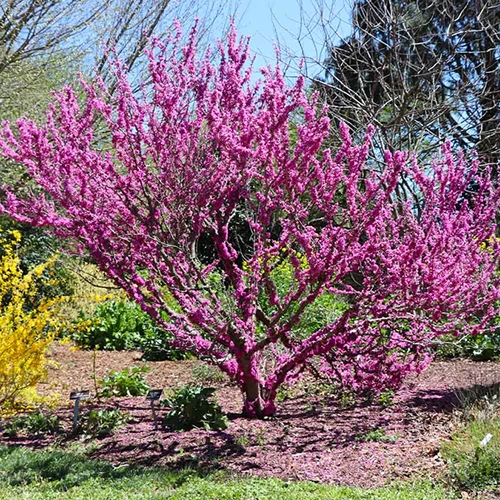
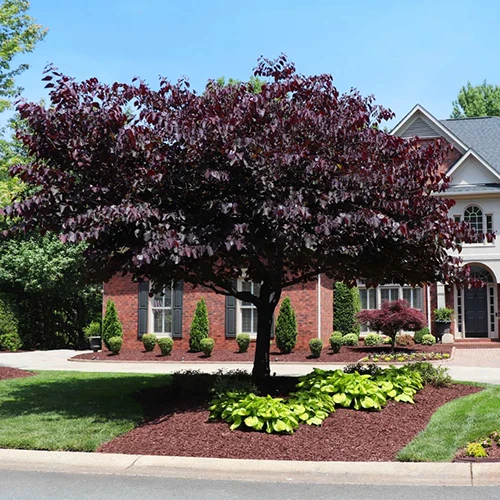


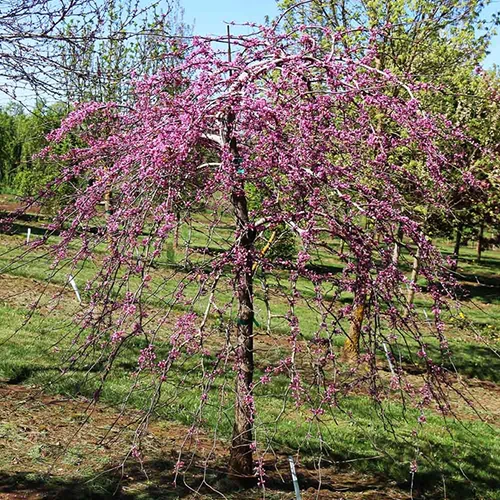
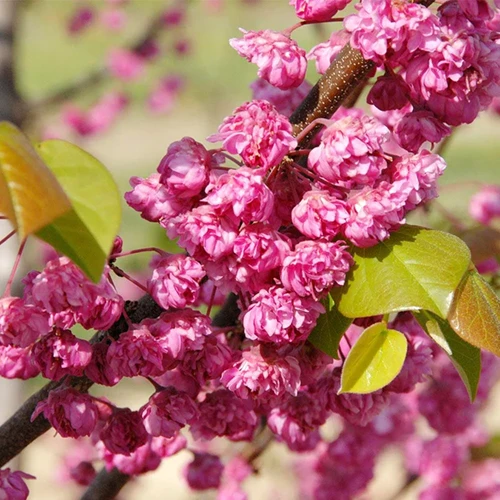
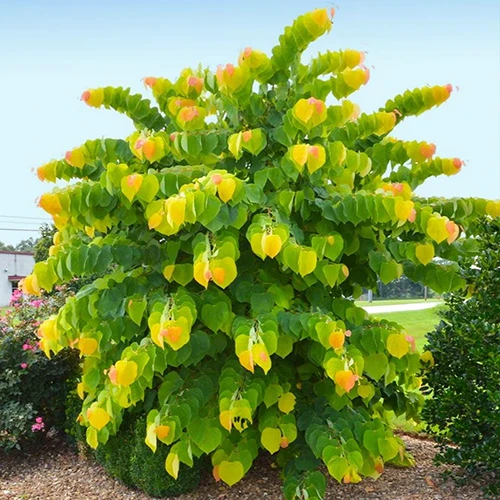
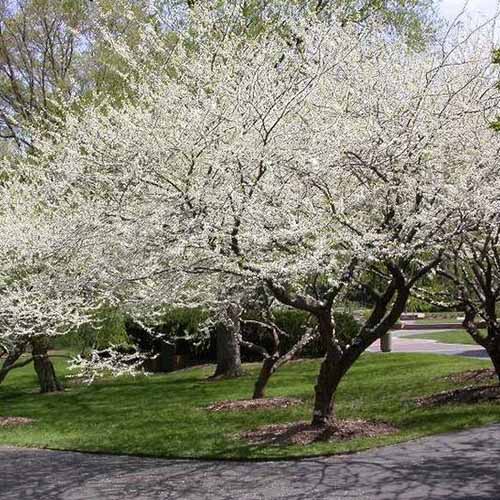
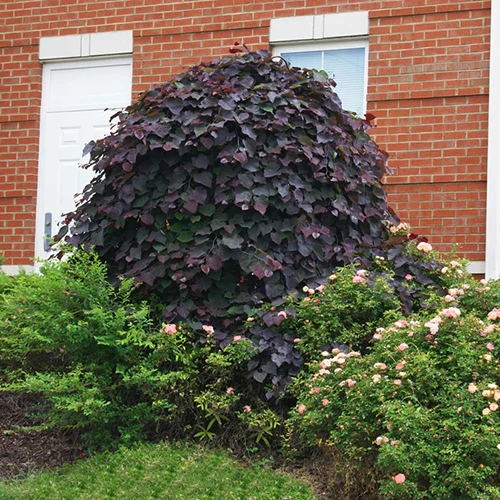
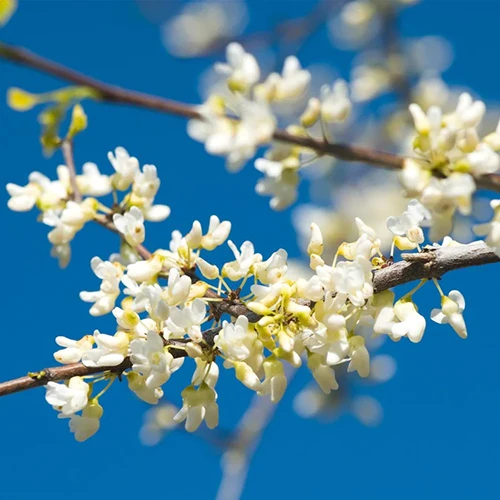
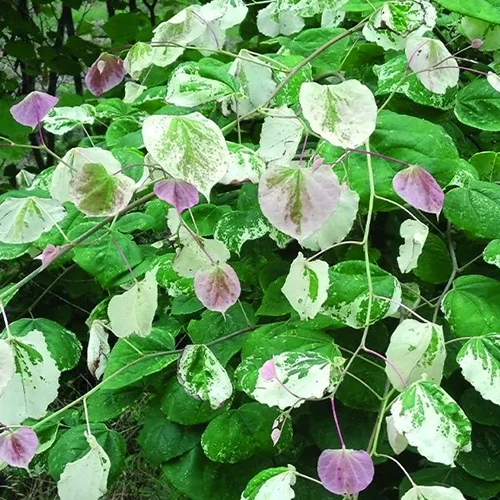
So many cool cultivars but has anyone worked on a verticillium wilt resistant cultivar? I won’t plant my favorite tree for customers anymore because of VM in the northeast.
Sadly, there aren’t any resistant cultivars on the market yet, and I totally understand your hesitancy. When verticillium hits, it’s pretty devastating. Vert has been on Cercis breeders’ minds for decades and I know they’re working on the issue, but only time will tell.
I saw a redbud at McDonalds Garden Center in Virginia Beach with small burgundy heart shaped leaves maybe only a quarter of an inch in length. I cannot remember the name. Any idea? They may have emerged along branches after the bloom, not sure if the leaves got bigger.
Hi Deborah, it sounds like you’re describing ‘Burgundy Hearts.’ There are a few redbuds with purple or burgundy leaves, but most of them have large leaves. ‘Forest Pansy’ has fairly small leaves, too.